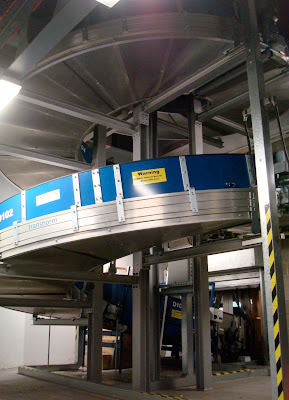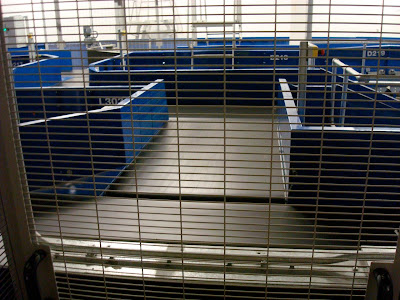
Ever wondered what happens to your suitcase after you set it down on the scales and it judders onto the conveyor belt behind the check-in desk?
I remember travelling home through Sheffield Airport one evening about five or six years ago. The conveyor belt at the side of the check-in desk didn’t move. Instead a man in overalls appeared and lifted my small case and carried it over to a door, went outside and loaded it by hand into the hold of the small aircraft. Later, he held the same door open as a handful of us walked out to board the aircraft. And before the plane taxied back from its stand, he had changed into a fireman’s uniform and was heading towards the airfield’s fire truck. A one man operation.
At Belfast City Airport, it’s a bit bigger, busier and more sophisticated. In fact, each bag goes on quite a magical adventure. And late one afternoon last week, I got a chance to discover what happened.
Shunting past the check in desk and rolling onto the conveyor belt running along the back of all the check-in desks, your bag vanishes through the wall into the baggage handling area behind.
Passengers and their hand luggage go through the scanners and X-ray machines in the main security hall before being allowed to go airside and wait to board their flights. In a parallel operation, each item of hold baggage is checked before it can join its owner on-board the flight.

Shunted through the wall, your bag will move onto a spiral conveyor belt and corkscrew its way upstairs.

It’ll spend the next minute travelling through an eerily dark upper floor.

A floor filled with belts, gates, blinking lights, and – crucially – an X-ray machine. (Obviously the lights were switched on while we were up there, otherwise the rest of the photographs would look similarly gloomy.)

Your bag will move from belt to belt, passing through a scanner which can detect a range of suspect and unwanted materials. The imaging of many bags will show nothing untoward and they will continue to travel through the channels of belt.
If the scanner sniffs certain substances it can automatically raise the alarm without further human intervention. Silent alarms go off, commandos descend on ropes from the ceiling, and miniature robotic helicopters hover around your suspect bag and use high powered lasers to neutralise the threat inside. (Disclaimer – I may have made that last sentence up.)
My suitcase with its 4-way coiled extension lead, spare laptop batteries, network cables and phone chargers may be flagged for closer inspection. Images of bags whose contents warrant human eyes to check the X-ray image (and verify what’s inside) are beamed to security staff downstairs.
While the your suspect bag sails on out the far side of the X-ray machine, the staff have 15 seconds or so to look at the X-ray images and make a decision about the bag’s contents. If it’s ok, it’ll continue down the happy path, inching closer to the plane.

If security don’t like what they see – or if they’re busy and don’t get time to make a decision – the system will automatically block your bag from following the safe route, and will instead divert it downstairs for manual scanning. Ultimately, you may be called back to open the back and allow the contents to be searched properly.
All the while it’s travelling through the dark maze of belts and machinery, infrared scanners read the barcodes affixed to the sides of your bag, tracking its progress to make sure it doesn’t get stuck or end up in the wrong place.
Finally, once your bag has passed through security and been deemed safe, it moves back down to ground level. Baggage handlers look at flight numbers on the labels and lift the bags off the belt and place them into the trailer destined for your flight. “Bingo cards” display the flight number prominently on each trailer ...

From there it’s a short trip out to the side of the aircraft. Your bag still hasn’t travel anywhere near as far as you will, snaking your way through security, up to the shops, cafes and airline lounges, before returning downstairs and making your way along the cold, long corridor to your gate and out to your plane.
I’ll explore outside in a later post. Thanks to the staff at Belfast City Airport for offering the tour.
5 comments:
Really interesting post Alan. I've been strangely curious and exceptionally nosy about what goes on behind the scenes with baggage handling ever since my first foreign holiday as a child!
No Woody or Buzz Lightyear sprints to be seen?
No - but if health and safety wasn't an issue it would be an incredible playground for eight year olds to scramble up and down ...
Intriguing insight, thanks Alan. That was like the blog post of an episode of Airport... I wonder what happend to Jeremy Spake? *googles* ah, apparently working for BA in Glasgow, as ya do. He'd undoubtedly be impressed by that corkscrew like chute!
It's like the scene in Toy Story 2... though with a lot less talking toys running around. It's pretty cool in its own way, in any case. It's something that would help flights be easier, and get the plane off the ground faster.
Post a Comment